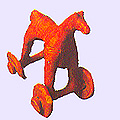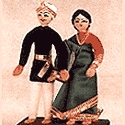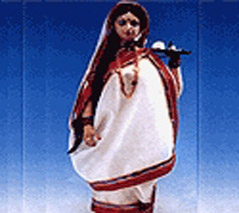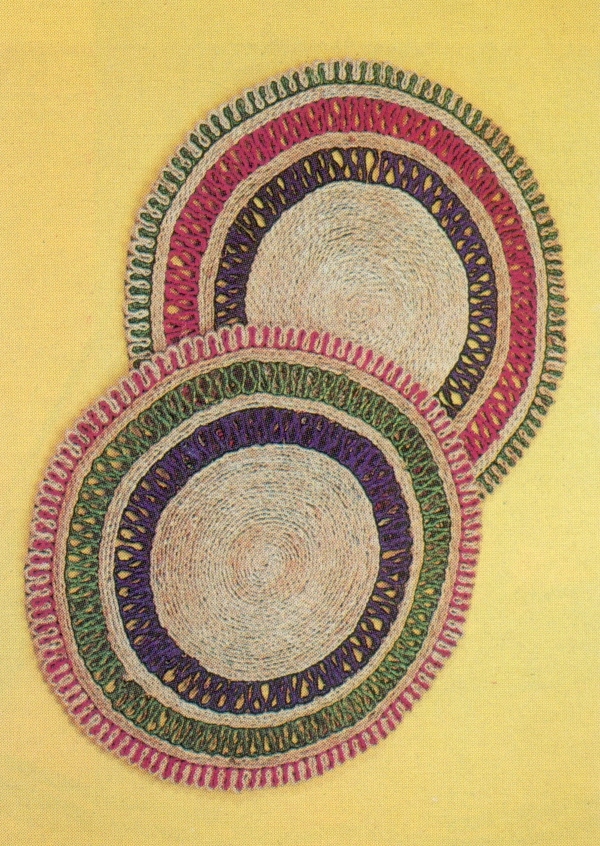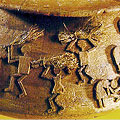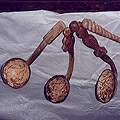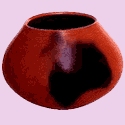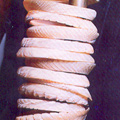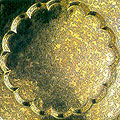The terracotta toys of Tamil Nadu are the most popular of the variety of toys made here and the craft is well entrenched in Chennai, Kanchipuram and parts of Arcot district. The artisans follow age-old techniques, with the craft being a hereditary tradition in the family. Clay toys are made in two stages: First plaster of Paris is mixed with tapioca powder into a paste and dried till it can be rolled into layers. This is pressed into the die to get the moulds. The raw material used is rock clay and, when properly moistened, is pushed into the mould after being dusted with French chalk powder so that it can be easily removed. It is then dried in the sun, after which it is ready for colouring. The work is well divided and the men knead the clay, roll it into layers and make the moulds and models, while the women use brushes to do the colouring with colours that are kept in coconut shells. Colours are used symbolically in these toys: a rich orange indicates men and women of a priestly class, and grays and russet indicate those in manual labour; the groom and bridal entourage are in shades of shimmering orange and pink while the rich folk are painted in bright colours and decorated with many embellishments. At Chennai, this art is practised by 300 artisan families from Cuddalore who have settled in Kosapet. Kanchipuram is also a well-known clay-toy making centre. Karigiri near Vellore is well known for its toy animals. A popular item is a toy zoo with a collection of wild animals made in glowing clay glazes. A variety of comic toys are called Chettiar toys. They are comical in appearance; some are in traditional garb with caste marks, sacred thread and a paunch. The modern-version wears trousers and a shirt and has an oscillating-head. A toy called gundu Chettiar is believed to bring good fortune and is bought by traders. The dolls that are used for the festival of Kolu or Dusserah are usually made of terracotta. Kolu is a festival where each household sets up a display of dolls and toys depicting stories from the epics and Puraanas. The artisans who produce these dolls and toys add new moulds to their stock every year. Thanjavur was once well known for its elegant oscillating toys; the centres now are Kumbakonam and Mayavaram. Clay toys from Panruti, near Cuddalore are very popular. These are painted in vegetable colours and made either by hand or in a mould. The toy-varieties are secular and religious and are in the naturalistic style showing village-scenes with people engaged in various occupations. They have a tradition of excellent workmanship and fine colouring.
Often, with not even an hour's travel, it is possible in Bangladesh to chance upon at least a few families of traditional potters still making the beautiful low temperature unglazed pottery that their forefathers have been making since time immemorial. The profusion of this craft is quite understandable when one considers the easy availability of soft alluvial soil in deltaic Bangladesh and the creativity of its artisans. The potters of Bangladesh follow traditional methods and have over thousands of years been crafting pottery to meet the domestic, ritual and ceremonial needs of the community around them. The terracotta temples built during 15th to 17th century show the skill and imagination of the potters at their best. During the 14th and 15th centuries, a number of mosques and mausoleums were built adopting local village architectural form of thatched house and using terracotta to decorate the outer surface. Clay and terracotta products for domestic pottery and as festival toys and artefacts are available throughout Bangladesh all year round. The figurines, objects and items of play have a long and ancient history emanating from the divinities, votive offerings and ceremonial pottery of thousands of years ago. The potters in Bangladesh have maintained this clarity of design, by using decoration only in so far as it enhances the natural beauty of form. Using the simple wheel and deft fingers, the potter moulds a profusion of domestic pottery which is remarkably functional. For water storage, the shape is one that keeps the contents cool; for cooking, the form preferred is that which conserves fuel. Larger vessels with elongated shapes or heavy jars with wide rimmed openings are used for storage. There are special pottery containers for different items that are as diverse as they are attractive. Clay items are made in Bangladesh in two traditional ways: on the wheel, and by the hand. In general all toys, dolls, figures (human and animal) are made by hand modelling or in a mould. Pots and pans, jars, bowls, pitchers and storage vessels etc. are made on the wheel, or by a combination of both techniques. The wheel work is traditionally the occupation of men whereas hand modelling, shaping finishing etc. is done by the women. Glazing, a relatively new technique has added a new dimension to the ceramic craft of Bangladesh. Glazing, ash trays and other products are crafted from Rayer Bazar clay.
Ladakh has two distinctive kinds of pottery --- one with large images and icons painted in bright colours which are made for Buddhist monasteries, and the other comprising of pottery artefacts like oil lamps, tea kettles, braziers, kitchen stoves, and barley wine pots. The potters of Ladakh makes everyday products like mud bowls, jugs, tea kettles, and braziers. The objects are moulded by hand with simple tools made of wood, leather, and stone. Zama, a wide vessel that is narrow at the neck and wide at the mouth is used to store the local barley beer. One of the most exclusive items is a large tea kettle complete with spout, lid, handle and a brazier. A large number of craftspersons are engaged in the preparation of statues --- like the Maitray Buddha and the Padma Sambhave --- for monasteries like the ones at Thiksay and Hemis monastery. Craftspersons also make masks of clay using cloth, flour, waste paper, and glue. These ingredients are mixed together in proportion and then hammered with a wooden beater on a smooth stone. The process continues till a thick dough is prepared. This dough gets shaped into different objects conceived of by the craftspersons. Lacquering is done twice to give a shine to the products. Glazed pottery known as Dal Gate pottery is found in Kashmir. Originally glazed tiles in deep green, blue, brown, and ochre were made, after which parts of tobacco pipes were produced. Now table ware and vases are made in red, green, and blue glazes. The most famous centre is the town of Chirar-e-Sharif near the Nund Rishi shrine.
A world in miniature, Karnataka's dolls depict everyday aspects of life: a melting pot of regional, professional and social diversities. They represent popular characters from Indian mythology and folklore and often take the shape of birds and animals. The simple raw materials --- cloth, clay, wire --- which go into the making of these dolls belie the great beauty of the finished product as well as the variety: wire dolls, cloth dolls, cone dolls, stuffed dolls, and soft dolls. The production of these dolls is extremely methodical. Wire is painstakingly bent to form the skeleton of the proposed doll, and the figure is wrapped tightly in cloth and stitched into a 'skin' of brown poplin cloth. The emerging figure is then dressed, ornamented, and painted.
Although the craft of making rag dolls is not traditional to West Bengal, yet over the years it has grown from the production of common craft dolls given to young children, to the making of more sophisticated, costumed and bejewelled dolls. Japanese rag dolls have greatly influenced the soft dolls of Bengal. Today most doll makers of West Bengal reside in Calcutta and its suburbs. Their work is distinguished by dancing girls, bride and bridegroom figures, santhal girls, and baul figures, and has won immense popularity among the young and old. Various techniques of stuffing, structuring, and limb formation, along with interesting detailing in costumes and jewellery are constantly invented and reinvented.
There is a special kind of heritage that lives in multiple paradoxical realms of value. It can be situated both in our collective memory- at the museums and vintage bars and also on the streets of labour. Today they may have achieved a status of antiquity, but they have been a great deal of function and utility since days of yore. Illustrating this paradox is the coal iron box that has been used to smoothen creases on clothes and crevices in our Indian society since ages. The coal-fuelled iron box which is the predecessor of the steam and electric iron is a highly underappreciated craft. Having a whole industry built around itself, the performance of everyday laundry would be incomplete without this tool. Originating from China in the first century BC, pressing machines were in the form of metal pans that were filled with burning coal. The stretched cloth would be swayed over by the pan and the released warm air would cause the fiber to relax. Craftspeople all over the world invented methods using different materials for several years. From the late 17th century, the pressing pans were transformed into boxes which would contain coal, giving the craft an edge of efficiency and prominence. It became a long standing tool and technique for pressing fabrics and is still in use this day. The hollow box would be constructed in the shape of a spade and have an insulated handle (made out of mud, wood) on top for the user. Before the usage of charcoal in the box in the 1800s, red-hot burning coals were used to keep the press running for long. The iron box would have small funnels on its sides to ensure sufficient air flow for the coal to burn and release smoke. However, due to the excessive toxic release and soot under this design, workers demanded a safer and efficient change in design. The 1850s ushered the technology of charcoal which ensured environmental and labour safety. The vent doors (funnels) would keep the charcoal lit for long. This technique was adopted across the globe and has been carrying forward to date. “Indian dhobi is the meekest of men.” - M.A Rutherfurd, The Indian Dhobi, The English Illustrated Magazine v25 1901 Contextualization of the craft and tradition surrounding this type of iron in the Indian socio-economic sphere leads us to a different understanding of the usage and performance around it. According to popular understanding, the dhobis, istriwallas, press wallas form the imagery for the industry that surrounds the coal iron box. The credit for the creation of such entities is often given to the East India Company who acknowledged this craft by launching it as an economic industry.Following those footsteps, the Indian government has established local laundry centers which are often referred to as dhobi ghats. A further peak in these dhobi ghats reveal the social inequalities that inhibit not only space but also living generations. Where it is often recognized that there is a special kind of wisdom and knowledge required to subjugate the wrinkles on different muslins, the cultural history of these workers are often forgotten. This industry is a testament to the materiality of caste divisions in the market. The soot on the walls of the jhuggies and the attached wash pens are symbolic of the current status of the sociality of the community. The then usage of coal emerged out of poverty and lack of better alternatives, but today the usage is majorly because of the hereditary quality of the skill and tools. Being considered a laborious profession with. In addition, the gender order that gets manipulated by the technology has also been invisibilized. Like other industries emerging from the households, ironing clothes was traditionally considered as a feminine duty until it was commercialized. To overthrow this dogma, men who entered this market preferred lifting the heavy iron load. By exhibiting the normative masculine conduct- of strength and vigor, the laundry market became heavily male-dominated. Today the face of the market is that of the iron man. The genealogy of ironing has not been recorded enough to understand the various contexts in which different tools and engineering were produced. However, archaeological evidence shows that coal iron underwent many modifications in design and technology. Studies have shown some vintage charcoal irons used in Asia and Africa dating till the 1890s, to be decorated with sculptures of birds. While these aesthetic modifications may have led the iron boxes to be part of museums and galleries, it is important to visualize the craft and community behind it.
The craft of coconut shell carving of Bankura district of West Bengal began as a variation of the infamous conch shell carving from the same region. During the 1980's there was a sudden scarcity in the supply of conch shells in West Bengal, as a result their prices soared. To sustain themselves and to keep the craft alive the craftsperson's then adapted their skills to carve coconut shells and also wood apple shells. They are also exploring some cheaper options, for instance pumpkin shells and fish scales. The tools and techniques used in the craft of conch shell carving are employed in the craft of coconut shell carving too. The products made from this craft range from teapots to bangles and ornaments, and from bowls to replicas of terracotta temples of Bishnupur.
Coconut shells, which were once thrown away or burnt are now a source of livelihood for the Assamese population, especially the self-help women groups. Depending on the quality, the coconut shells are first collected as raw materials and placed under the sun for 7 to 15 days. Post the carving and shape manipulation of the shell, as per the design, the outer portion is smoothed using a sand paper. Various other materials such as coir yarn, bamboo are added for ornamentation of the products. Varnish is applied on the products for a finished touch. The process is said to be bio-degradable and environment friendly. The product range has developed over time from decorative items to utility based products - bowls, pen holders, lamps, purses to name a few.
Another popular plant fibre, Jute is found in abundance in Assam. The first preparatory step includes retting - where the jute fiber is extracted from the stem of the jute plant by bundling the jute stems and finally dipping in running water. The plant is then stripped where the non-fibrous matter is scraped off to get the jute fiber. The fiber can now take various forms and is usually converted into yarn of varied thickness. While the fine quality jute yarn is mostly used for textile - converted into garments, bags, shoes; other popular product range of jute includes hangings, coasters, mats, baskets and jewellery.
This is a versatile craft and the articles made out of coconut shells range from table lamps and finger bowls to boxes and even jewellery. Basketry and mat-weaving are traditional crafts of the Nicorbarese and are usually done by the women in their leisure time. Mats are made from coconut stems and pandanus leaves and are used for sitting, sleeping, and making the walls of huts. Very often light and dark leaves are interwoven to create intricate patterns. The mats are soft, light, and cool, and have a glossy surface.
Coconut trees grow all over the coast line of Bangladesh and the versatile coconut is a fruit which is used in its entirety with not even a single part of it being wasted. From the coconut shell products like bowls, vases, tea pots, masks and hookahs are crafted. Lamp stands encased in brass, dolls and toys decorated with beads and coloured threads, baskets and mats are all made from this very versatile abundantly available natural resource. Their convenience and reasonable prices make mats made from coconut stems a popular item widely used for sitting, sleeping, and making the walls of huts. Very often light and dark leaves are interwoven to create intricate patterns. The mats are soft, light, and cool, and have a glossy surface. Coir Fibre was used traditionally used in Bangladesh to make twines and doormats; with design innovation its usage has now extended to the making of beautiful carpets and prayer rugs. Simple tools such as hacksaws and knives are used to craft the products, while varnish is used for the final finish.
Ubiquitous coconut plantations sustain the farmers of Goa, as it is a rich source of economically viable products. The coconut thatch, timber, roof, rope and shell and fiber are used to produce variety of handicrafts. The trees yield fuel, building material, liquor and oil with every part of the tree being utilized.
Coir Dori - Rope Making Ropes are made from the fiber obtained from the husk of a coconut - called coir. The coconut is kept buried in slush near the sea for a year to soften the fiber; then the husk is removed by hand and beaten till it becomes fine, and is finally dried. The fibre is pulled out and twisted to form a strand. This is then doubled and twisted to form the rope. More fibres are twisted when required, to make a continuous length.
Coconut Frond Plaiting The fronds of the coconut leaves are plaited when green and then dried for making utility items such as roof thatch, cover to protect mud walls, rain shields, sandals, bags and shutters for windows. These products provide a soothing relief in the heat and humidity of the Konkan coast. Interestingly, the Konkan Railway Corporation has erected thatched shelters for the benefit of travellers at most of the railway stations along the Konkan and Malabar coasts.
Saran - Brooms Brooms are made of both green and dry coconut leaves by first removing the central thick vein of the coconut leaf. Then, the fronds are stripped with a knife and cleaned till they are fine and smooth. Once all the veins are stripped, the thick end of the tapering vein is taken as the top and the fibres are braided (3-ply) in such a way that veins end up in a line, connected to each other by the braided line on top. The rope is extended beyond the last stick by twisting a length of coconut husk into it. The sticks are then wound round to form the saran, with a conical cap of braided husk. Brooms are also made from date palm leaves.
The coconut shell - a versatile raw material - has several innovative uses. The coconut shell - generally thrown away as a waste material - can and was shaped by some as a kitchen spoon, using one half of a cracked shell. It was also used as a mould for making sweetmeats, a tradition that continues to this day. The two covers used to press the mixture by hand were carved with traditional floral and leaf designs. In temples the shell was fitted onto a handle and was used to pour or sprinkle water.
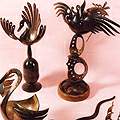
- Gampaha district (next to Colombo): in the village of Mirigama.
- Kegalle district(between Colombo and Kandy): in the village of Garagoda.
- Moneragala district (adjoins Ratnapura district): this craft is practised in the villages of Inginiyagala, Nannapurawa, and Potuliyadda.
- Ratnapura district (in the south-western part of the country): in the villages of Eratne, Medapola, Wikiliya, Hidella, Kuruvita, and Hiramadagama.
Both fine and coarse varieties of coir fibre, locally found in the coastal areas, are used. The artisan conceptualises the motifs. The designs are created by piling the coir and tying it with a strong thread. By tying the thread in a zigzag net style, the design is highlighted. The coir is coloured to give it an attractive appearance. This craft is practised mainly at Puri, Sakhigopal, Batamangala, Pipli, Bhubaneswar and Kendrapara.
The conch and shell crafts of Bangladesh are famed throughout South Asia. During the last five centuries, Dhaka, situated on the banks of the river Buriganga, has been renowned as the centre of highly skilled shell carvers, commonly known as Shankharis or Shankhabaniks. A distinct community, their products are in demand not only within Bangladesh but abroad as well. The master craftsmen of Shankari Patti produce high quality products known as Sankha. These ornaments are richly decorated with carvings, coloured with lacquer or inlaid with bands of gold. The products crafted from the conch-shell include exquisite hair bands, bracelets, rings, lockets, pendants and amulets, ear rings and necklaces. Delicate bangles are also crafted from conch-shell and are essential part of a Hindu woman’s trousseau. These are embellished with notched edges or diamond shapes along the centre.
Practiced by the community of Muslim Lohars in the Nirona and Zura villages of Banni, thee copper coated iron bells of Gujarat cater to the indigenous pastoral communities of Kutch. Bells of various sizes are crafted by the entire families working together as a team. The task of shaping the bell is assigned to the male members of the families. Tools such as compass, hammer and pliers are used in the crafting process.

In the Kathmandu Valley at Lalitpur - in the areas surrounding the famous temple of Mahabuddha - there existed places where copper-coin making was first started many centuries ago, and continued to be practised until a few decades ago. This art and craft has now died out completely - copper coins can only be found in museums and in personal collections or with antique dealers. Around the temple of Mahabouddha there are places that still show large deposits of iron slags called taksar and there are still certain localities called Taksar, specially at Palpa Tansen and Bhojpur, indicating that in the ancient days copper coins were minted here. The inhabitants here claim their descent from the Sakyas or Bajracharyas of Lalitpur. According to old records, a Nepalese Buddhist scholar Abhaya Raj Sakya returned to Lalitpur from Bodh Gaya in India and started the construction of the Mahabauddha temple in a similar architectural style of an Indian Mahabauddha temple he had visited. The records maintained state that he was later made the head (naike) of the copper coin mint on the demise of his father who was the previous head of the mint.
The craft of lac coloured metals popularly known as Moradabadi work has been popular in Rajasthan for close to a century. It can be seen as a cheaper imitation of bidri work. On a surface of plain or gilded brass or copper vessels, floral ornamentations in relief are created by chasing and punching away the background around the relief work. The areas thus chased are then filled up with black lac, fused by a hot bolt and the excess rubbed off with sand paper or powdered brick. Thus, a minute glittering floral design is obtained against a black background. This craft is known as Marori. The reverse of this. i.e. when the pattern is in black or any other coloured lac and the background in copper or brass is called chrakwan. In Jaipur, both forms are practiced using a lac of varying colours


